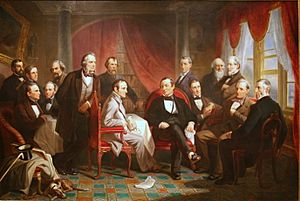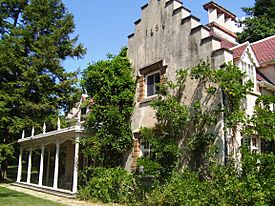Sunnyside (Tarrytown, New York) facts for kids
|
Sunnyside
|
|
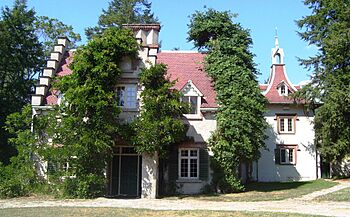
View from the south (2012)
|
|
| Location | West Sunnyside Lane Tarrytown, New York |
|---|---|
| Nearest city | White Plains |
| Area | 10 acres (4 ha) |
| Built | 1835 |
| Architect | George Harvey |
| Architectural style | Dutch Colonial Revival, Scottish Gothic, Tudor Revival, Romantic |
| NRHP reference No. | 66000583 |
Quick facts for kids Significant dates |
|
| Added to NRHP | October 15, 1966 |
| Designated NHL | December 29, 1962 |
Sunnyside is a famous old house built in 1835. It sits on 10 acres (4 hectares) of land next to the Hudson River in Tarrytown, New York. This beautiful home belonged to Washington Irving, a well-known American author.
Irving is famous for his short stories, like "Rip Van Winkle" (written in 1819) and "The Legend of Sleepy Hollow" (written in 1820). Sunnyside was named a National Historic Landmark in 1962. This means it is a very important place in American history.
The house looks like a charming cottage. It mixes different styles, including Dutch Colonial Revival, Scottish Gothic, and Tudor Revival. You can see its unique look with wisteria vines covering the entrance and a cool, jagged roofline called a crow-stepped gable.
Contents
History of Sunnyside
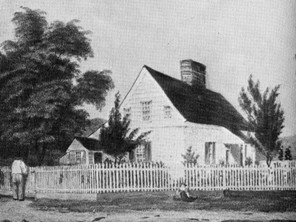
The story of Sunnyside began almost 200 years before Washington Irving bought it. A Dutch-American man named Wolfert Acker lived in the area. His property was called Wolfert's Roost. It was part of a larger estate known as the Philipsburg Manor.
On Wolfert's Roost, there was a simple two-room stone farmhouse. It was built around 1650. Later, the Van Tassel family owned the property. They were related to the Eckert family (another spelling for Acker). The Van Tassels owned the land until 1802.
In 1802, about 150 acres (61 hectares) of the land were sold to the family of Benson Ferris. His wife, Maria Acker, was a descendant of Wolfert Acker. Washington Irving later made the Van Tassel family name famous in his short story "The Legend of Sleepy Hollow" (1820).
Washington Irving's Home
In 1832, Washington Irving visited his nephew, Oscar Irving, who lived near the old stone farmhouse. Irving had just traveled through the prairies of the Arkansas and Mississippi Rivers. He felt sad that he didn't have a home of his own. He had spent most of his adult life staying in other people's houses.
Irving really wanted a home. He wrote that he was "willing to pay a little unreasonably for it." On June 7, 1835, Irving finally bought the property for $1,800. Over the years, he bought more land to make his estate larger.
Irving wrote a story called "Wolfert's Roost" about the original owner, Wolfert Acker, and the land. He told his brother Peter that it was "a beautiful spot, capable of being made a little paradise." He planned to build onto the old house that summer. Irving wanted to create a "little nookery" in the Dutch style. He wanted it to be unique but not too fancy. He also wanted it to be made of stone.
Irving asked his friend, George Harvey, to help him design the house and the gardens. Harvey was an English painter and neighbor. They created a Romantic style landscape. This included a pond that Irving called "The Little Mediterranean." A stream called Sunnyside Brook fed the pond, and a waterfall led to a winding stream.
The house became very well known. It appeared in Harper's Weekly magazine and in travel guides. Oliver Wendell Holmes Sr. said that Sunnyside was "next to Mount Vernon, the best known and most cherished of all the dwellings in our land." Many visitors came to see the home and America's first literary star, Washington Irving. They hoped to see him working.
In 1842, Irving became the Ambassador to Spain. He left Sunnyside in the care of his brother Ebenezer. Ebenezer lived there with his four grown daughters, who managed the house. Irving wrote that the hardest part of his new job was leaving "dear little Sunnyside." He returned to New York on September 19, 1846.
Soon after returning, in 1847, Irving added the "Spanish Tower" to the cottage. This tower was inspired by Spanish monastery buildings and the Alhambra in Granada. It added four new bedrooms to the house.
In his later years at Sunnyside, Irving finished his "crowning effort." This was a five-volume biography of his namesake, George Washington. Irving finished the book just weeks before he passed away. He died of a heart attack in his bedroom at Sunnyside on November 28, 1859. He was 76 years old.
How Sunnyside Got Its Name
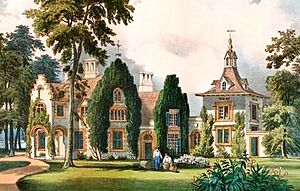
According to a book by language expert Laura Wright, Irving found the name "Sunnyside" during a visit in 1816. He was visiting Sir Walter Scott's castle, Abbotsford House, in Scotland. Near the castle, there was a farm on a hill called "Sunnyside." Irving liked the name and later used it for his own home.
Sunnyside as a Museum
The Irving family lived in the cottage until 1945. That year, Louis Irving sold it to John D. Rockefeller Jr.. Rockefeller bought the house to help with historic preservation. The house was restored, which included removing a Victorian style addition on the north side. Sunnyside opened to the public as a museum in 1947.
Today, Historic Hudson Valley operates Sunnyside as a museum. Visitors pay an admission fee to enter. Guides dressed in old-fashioned costumes lead tours through the house. The museum has many of Irving's original furniture and belongings. For example, all the furniture and most items in his writing study are original.
Visitors can explore Irving's study, dining room, parlor, kitchen, and most of the bedrooms. These rooms contain many of the original items owned by the Irving family. Some other furnishings from that time period have also been added.
Sunnyside was officially named a National Historic Landmark in 1962.
Gallery
-
The stepped-gabled west side of the house faces the Hudson River. The porch, which Irving called his "piazza," is beyond it. It's not clear why Irving put "1656" on the wall, as the original cottage was built in the 1690s.
See also




